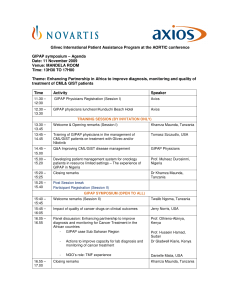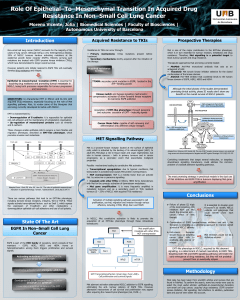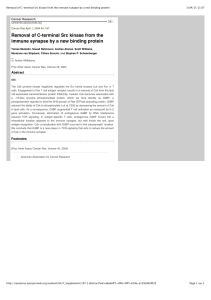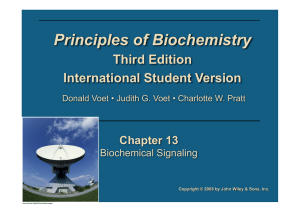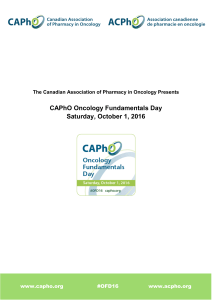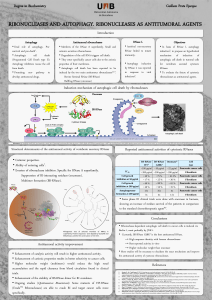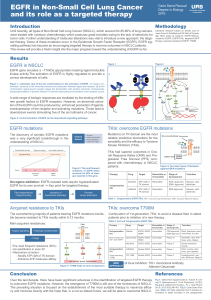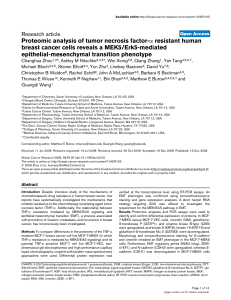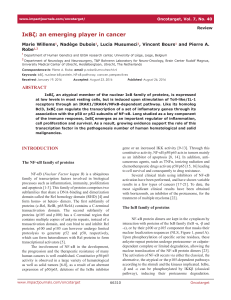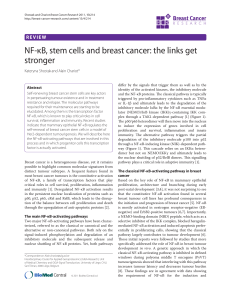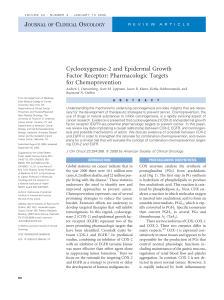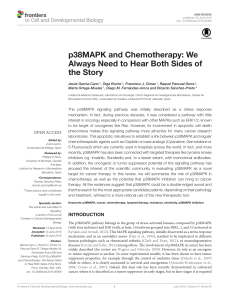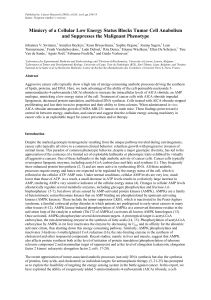Rational drug design and resistance in chronic myelogenous leukemia
publicité
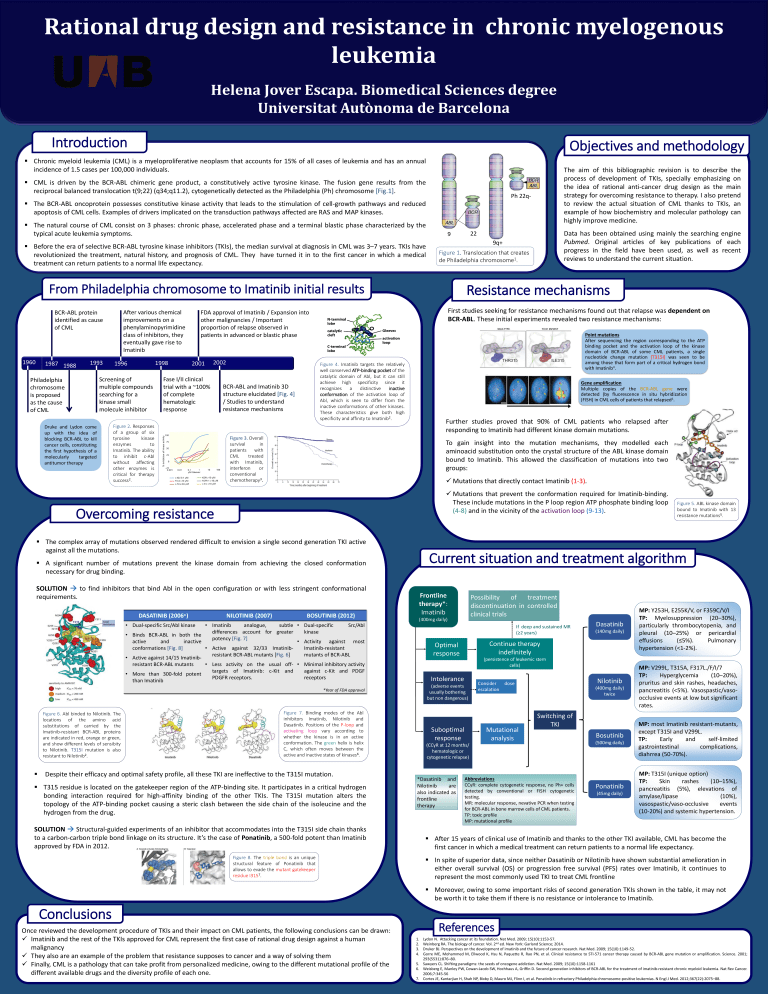
Rational drug design and resistance in chronic myelogenous leukemia Helena Jover Escapa. Biomedical Sciences degree Universitat Autònoma de Barcelona Introduction Objectives and methodology Chronic myeloid leukemia (CML) is a myeloproliferative neoplasm that accounts for 15% of all cases of leukemia and has an annual incidence of 1.5 cases per 100,000 individuals. CML is driven by the BCR-ABL chimeric gene product, a constitutively active tyrosine kinase. The fusion gene results from the reciprocal balanced translocation t(9;22) (q34;q11.2), cytogenetically detected as the Philadelphia (Ph) chromosome [Fig.1]. The aim of this bibliographic revision is to describe the process of development of TKIs, specially emphasizing on the idea of rational anti-cancer drug design as the main strategy for overcoming resistance to therapy. I also pretend to review the actual situation of CML thanks to TKIs, an example of how biochemistry and molecular pathology can highly improve medicine. Ph 22q- The BCR-ABL oncoprotein possesses constitutive kinase activity that leads to the stimulation of cell-growth pathways and reduced apoptosis of CML cells. Examples of drivers implicated on the transduction pathways affected are RAS and MAP kinases. The natural course of CML consist on 3 phases: chronic phase, accelerated phase and a terminal blastic phase characterized by the typical acute leukemia symptoms. Before the era of selective BCR-ABL tyrosine kinase inhibitors (TKIs), the median survival at diagnosis in CML was 3–7 years. TKIs have revolutionized the treatment, natural history, and prognosis of CML. They have turned it in to the first cancer in which a medical treatment can return patients to a normal life expectancy. 9q+ Figure 1. Translocation that creates de Philadelphia chromosome1. From Philadelphia chromosome to Imatinib initial results After various chemical improvements on a phenylaminopyrimidine class of inhibitors, they eventually gave rise to Imatinib BCR-ABL protein identified as cause of CML 1960 1987 1988 1993 1998 1996 Screening of multiple compounds searching for a kinase small molecule inhibitor Philadelphia chromosome is proposed as the cause of CML Druke and Lydon come up with the idea of blocking BCR-ABL to kill cancer cells, constituting the first hypothesis of a molecularly targeted antitumor therapy Resistance mechanisms First studies seeking for resistance mechanisms found out that relapse was dependent on BCR-ABL. These initial experiments revealed two resistance mechanisms: FDA approval of Imatinib / Expansion into other malignancies / Important proportion of relapse observed in patients in advanced or blastic phase 2001 2002 Fase I/II clinical trial with a ~100% of complete hematologic response Figure 2. Responses of a group of six tyrosine kinase enzymes to Imatinib. The ability to inhibit c-Abl without affecting other enzymes is critical for therapy success2. Point mutations After sequencing the region corresponding to the ATP binding pocket and the activation loop of the kinase domain of BCR-ABL of some CML patients, a single nucleotide change mutation (T315I) was seen to be among those that form part of a critical hydrogen bond with Imatinib4. Figure 4. Imatinib targets the relatively well conserved ATP-binding pocket of the catalytic domain of Abl, but it can still achieve high specificity since it recognizes a distinctive inactive conformation of the activation loop of Abl, which is seen to differ from the inactive conformations of other kinases. These characteristics give both high specificity and affinity to Imatinib2. BCR-ABL and Imatinib 3D structure elucidated [Fig. 4] / Studies to understand resistance mechanisms Gene amplification Multiple copies of the BCR-ABL gene were detected (by fluorescence in situ hybridization (FISH) in CML cells of patients that relapsed4. Further studies proved that 90% of CML patients who relapsed after responding to Imatinib had different kinase domain mutations. Figure 3. Overall survival in patients with CML treated with Imatinib, interferon or conventional chemotherapy3. To gain insight into the mutation mechanisms, they modelled each aminoacid substitution onto the crystal structure of the ABL kinase domain bound to Imatinib. This allowed the classification of mutations into two groups: Mutations that directly contact Imatinib (1-3). Mutations that prevent the conformation required for Imatinib-binding. These include mutations in the P loop region ATP phosphate binding loop (4-8) and in the vicinity of the activation loop (9-13). Overcoming resistance The complex array of mutations observed rendered difficult to envision a single second generation TKI active against all the mutations. SOLUTION to find inhibitors that bind Abl in the open configuration or with less stringent conformational requirements. NILOTINIB (2007) BOSUTINIB (2012) • Dual-specific Src/Abl kinase • Imatinib analogue, subtle • Dual-specific Src/Abl differences account for greater kinase • Binds BCR-ABL in both the potency [Fig. 7] active and inactive • Activity against most conformations [Fig. 8] • Active against 32/33 ImatinibImatinib-resistant resistant BCR-ABL mutants [Fig. 6] mutants of BCR-ABL • Active against 14/15 Imatinibresistant BCR-ABL mutants • Less activity on the usual off- • Minimal inhibitory activity targets of Imatinib: c-Kit and against c-Kit and PDGF • More than 300-fold potent PDGFR receptors. receptors than Imatinib Frontline therapy*: Imatinib If deep and sustained MR (≥2 years) T315 residue is located on the gatekeeper region of the ATP-binding site. It participates in a critical hydrogen bonding interaction required for high-affinity binding of the other TKIs. The T315I mutation alters the topology of the ATP-binding pocket causing a steric clash between the side chain of the isoleucine and the hydrogen from the drug. (adverse events usually bothering but non dangerous) Suboptimal response Consider escalation Nilotinib dose Mutational analysis (400mg daily) twice Switching of TKI (CCyR at 12 months/ hematologic or cytogenetic relapse) SOLUTION Structural-guided experiments of an inhibitor that accommodates into the T315I side chain thanks to a carbon-carbon triple bond linkage on its structure. It’s the case of Ponatinib, a 500-fold potent than Imatinib approved by FDA in 2012. (140mg daily) (persistence of leukemic stem cells) Intolerance *Dasatinib and Nilotinib are also indicated as frontline therapy Dasatinib Continue therapy indefinitely Optimal response Figure 7. Binding modes of the Abl inhibitors Imatinib, Nilotinib and Dasatinib. Positions of the P-loop and activating loop vary according to whether the kinase is in an active conformation. The green helix is helix C, which often moves between the active and inactive states of kinases6. Despite their efficacy and optimal safety profile, all these TKI are ineffective to the T315I mutation. Possibility of treatment discontinuation in controlled clinical trials (400mg daily) *Year of FDA approval Figure 6. Abl binded to Nilotinib. The locations of the amino acid substitutions of carried by the Imatinib-resistant BCR-ABL proteins are indicated in red, orange or green, and show different levels of sensibity to Nilotinib. T315I mutation is also resistant to Nilotinib2. Figure 5. ABL kinase domain bound to Imatinib with 13 resistance mutations5. Current situation and treatment algorithm A significant number of mutations prevent the kinase domain from achieving the closed conformation necessary for drug binding. DASATINIB (2006*) Data has been obtained using mainly the searching engine Pubmed. Original articles of key publications of each progress in the field have been used, as well as recent reviews to understand the current situation. 22 9 Abbreviations CCyR: complete cytogenetic response, no Ph+ cells detected by conventional or FISH cytogenetic testing. MR: molecular response, nevative PCR when testing for BCR-ABL in bone marrow cells of CML patients. TP: toxic profile MP: mutational profile Bosutinib (500mg daily) Ponatinib (45mg daily) MP: Y253H, E255K/V, or F359C/V/I TP: Myelosuppression (20–30%), particularly thrombocytopenia, and pleural (10–25%) or pericardial effusions (≤5%). Pulmonary hypertension (<1-2%). MP: V299L, T315A, F317L./F/I/7 TP: Hyperglycemia (10–20%), pruritus and skin rashes, headaches, pancreatitis (<5%). Vasospastic/vasoocclusive events at low but significant rates. MP: most Imatinib resistant-mutants, except T315I and V299L. TP: Early and self-limited gastrointestinal complications, diahrrea (50-70%). MP: T315I (unique option) TP: Skin rashes (10–15%), pancreatitis (5%), elevations of amylase/lipase (10%), vasospastic/vaso-occlusive events (10-20%) and systemic hypertension. After 15 years of clinical use of Imatinib and thanks to the other TKI available, CML has become the first cancer in which a medical treatment can return patients to a normal life expectancy. Figure 8. The triple bond is an unique structural feature of Ponatinib that allows to evade the mutant gatekeeper residue I3157. In spite of superior data, since neither Dasatinib or Nilotinib have shown substantial amelioration in either overall survival (OS) or progression free survival (PFS) rates over Imatinib, it continues to represent the most commonly used TKI to treat CML frontline Moreover, owing to some important risks of second generation TKIs shown in the table, it may not be worth it to take them if there is no resistance or intolerance to Imatinib. Conclusions Once reviewed the development procedure of TKIs and their impact on CML patients, the following conclusions can be drawn: Imatinib and the rest of the TKIs approved for CML represent the first case of rational drug design against a human malignancy They also are an example of the problem that resistance supposes to cancer and a way of solving them Finally, CML is a pathology that can take profit from personalized medicine, owing to the different mutational profile of the different available drugs and the diversity profile of each one. References 1. 2. 3. 4. Lydon N. Attacking cancer at its foundation. Nat Med. 2009; 15(10):1153-57. Weinberg RA. The biology of cancer. Vol. 2nd ed. New York: Garland Science; 2014. Druker BJ. Perspectives on the development of imatinib and the future of cancer research. Nat Med. 2009; 15(10):1149-52. Gorre ME, Mohammed M, Ellwood K, Hsu N, Paquette R, Rao PN, et al. Clinical resistance to STI-571 cancer therapy caused by BCR-ABL gene mutation or amplification. Science. 2001; 293(5531):876–80. 5. Sawyers CL. Shifting paradigms: the seeds of oncogene addiction. Nat Med. 2009; 15(10):1158-1161 6. Weisberg E, Manley PW, Cowan-Jacob SW, Hochhaus A, Griffin D. Second generation inhibitors of BCR-ABL for the treatment of imatinib-resistant chronic myeloid leukemia. Nat Rev Cancer. 2006;7:345-56 7. Cortes JE, Kantarjian H, Shah NP, Bixby D, Mauro MJ, Flinn I, et al. Ponatinib in refractory Philadelphia chromosome-positive leukemias. N Engl J Med. 2012;367(22):2075–88.
